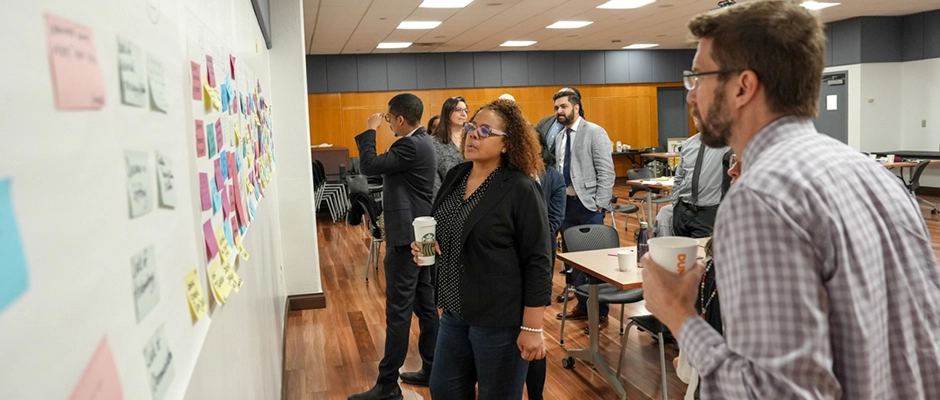Teaching and Learning
Contact Us
Room: E-Building, E-512
Phone: (718) 482-6119
IE@lagcc.cuny.edu

Pillar Goals
Ensure Students Build the Competencies, Skills, and Dispositions Needed for Success in Education and Careers
- Graduation (FTFT freshmen 3-year)
- Graduation ASAP (FTFT freshmen 3-year)
- Percentage of 20 or more credits in first year
- Percentage of FTFT freshmen passing Gateway English in first year
- Percentage of FTFT freshmen passing Gateway Math in first year
- Benchmark scores for core competencies:
- Inquiry and problem solving
- Global learning
- Integrative learning
- Benchmark scores for communication abilities:
- Written
- Verbal
- Digital
- ✓ CUNY Lifting New York KPIs
- ✓ Middle States
- 32% (2030 CUNY)
Action: Increase faculty professional development in high-impact practices, including culturally responsive teaching, equity-minded practices, online teaching, course design, AI and learning outcome assessment
- Full-time faculty participation in CTL programs
- Adjunct faculty participation in CTL programs
- ACE faculty participation in CTL programs
- Percentage of employees who participate in external or internal professional development, leadership, or mentoring programs
- Percentage of employees who complete mandatory workplace trainings (Workplace Violence Prevention, ESPARFC, etc.)
- ✓ CUNY Lifting New York KPIs
- ✓ Middle States
- 80% Professional Development (2030 CUNY)
- 100% Mandatory training (2030 CUNY)
Action: Increase use of academic data to identify barriers to student progression and direct resources accordingly, for example, to courses with high DFWI rates or limited availability
- DFWI gap in core courses between URM and non-URM students
- ✓ CUNY Lifting New York KPIs
- DFWI gap -8 (2030 CUNY)
Action: Increase enrollment in First-Year Seminar during students’ first semester
- Percentage of students that complete FYS in their first semester
- Percentage of students that complete FYS in their first year
- GPA of FYS students compared to non-FYS students
- Percentage of credits attempted/earned by FYS students vs. non-FYS students
- 1 semester return rates of FYS students compared to non-FYS students
Action: Promote a culture of student responsibility in which students commit to their academic success and meet the college’s expectations for their effort, participation, and contributions
Action: Increase the number of students who have access to, and utilize, tutoring services
- Student participation in academic support activities /tutoring
- Evaluation by annual student survey
- Utilization rates based on schedule, delivery format, and subject area
- GPA and pass rates of students who access tutoring vs those that do not
- ✓ Middle States
Action: Schedule classes based on student demand
- Evaluation by annual student survey
- Fill rates by time/time of day/course format
Action: Increase opportunities for experiential and global learning
- Number of courses with experiential learning content/activities
- Number of students participating in GEL, COIL, LHI courses and activities
Action: Increase support for faculty research that provides experiential learning opportunities
- Number of research grants awarded to faculty
- Monetary value of research grants awarded to faculty
- Number of all grants awarded to faculty
- Monetary value of all grants awarded to faculty
- ✓ Middle States
- 6 Research grants (2030 CUNY)
- $616,000 Research grants amount (2030 CUNY)
Action: Provide regular assessment of academic programs to ensure positive outcomes for students and drive continuous improvement
- Annual evaluation of program-level data and outcomes
Ensure that All Students Benefit from Meaningful Academic Advising
- 1-semester retention (FTFT freshmen)
- 1-year retention (FTFT freshmen)
- ✓ CUNY Lifting New York KPIs
- 66% 1-year retention (2030 CUNY)
Action: Coordinate academic advising systems, protocols, training, and practices for professional advisors and faculty mentors to ensure students receive consistent, proactive support across all advising and mentoring units; in doing so, develop a common standard of care for all students, regardless of advising unit (ASAP, CD, SAS)
- Average advising caseload – SAS
- Average advising caseload – ASAP
- Percentage of degree-seeking students receiving advising support
- Retention/Graduation gaps for students with advising vs non-advised
- Next semester GPA gap for students with advising vs non-advised
Action: Support students’ degree planning to prevent unintended accumulation of excess credits
- Average number of credits per graduates who started as freshmen
Action: Enrich the student experience by bringing advisors and faculty mentors together for ongoing PD to support inclusive advising and data-informed intervention practices, enabled by tools such as EAB Navigate and Brightspace
Action: Ensure that advising services are available outside of regular working hours
- Evaluation by annual student survey
- Number of hours scheduled outside of regular working hours
- Number of students served outside of regular working hours
- ✓ Middle States
Increase Transfer Rates
- Percentage of associate degree transfer within two years of graduation
- 6-year baccalaureate graduation (FTFT freshmen)
- ✓ CUNY Lifting New York KPIs
- 34% baccalaureate graduation (2030 CUNY)
Action: Develop and implement a transfer experience that enables students to move seamlessly and successfully between CUNY campuses with appropriate supports, such as peer mentors
Action: Provide faculty, advisors, and student success mentors with discipline-specific professional development so they can guide students along their career and transfer pathways
- Number of faculty, advisors, and student success mentors accessing discipline-specific professional development
